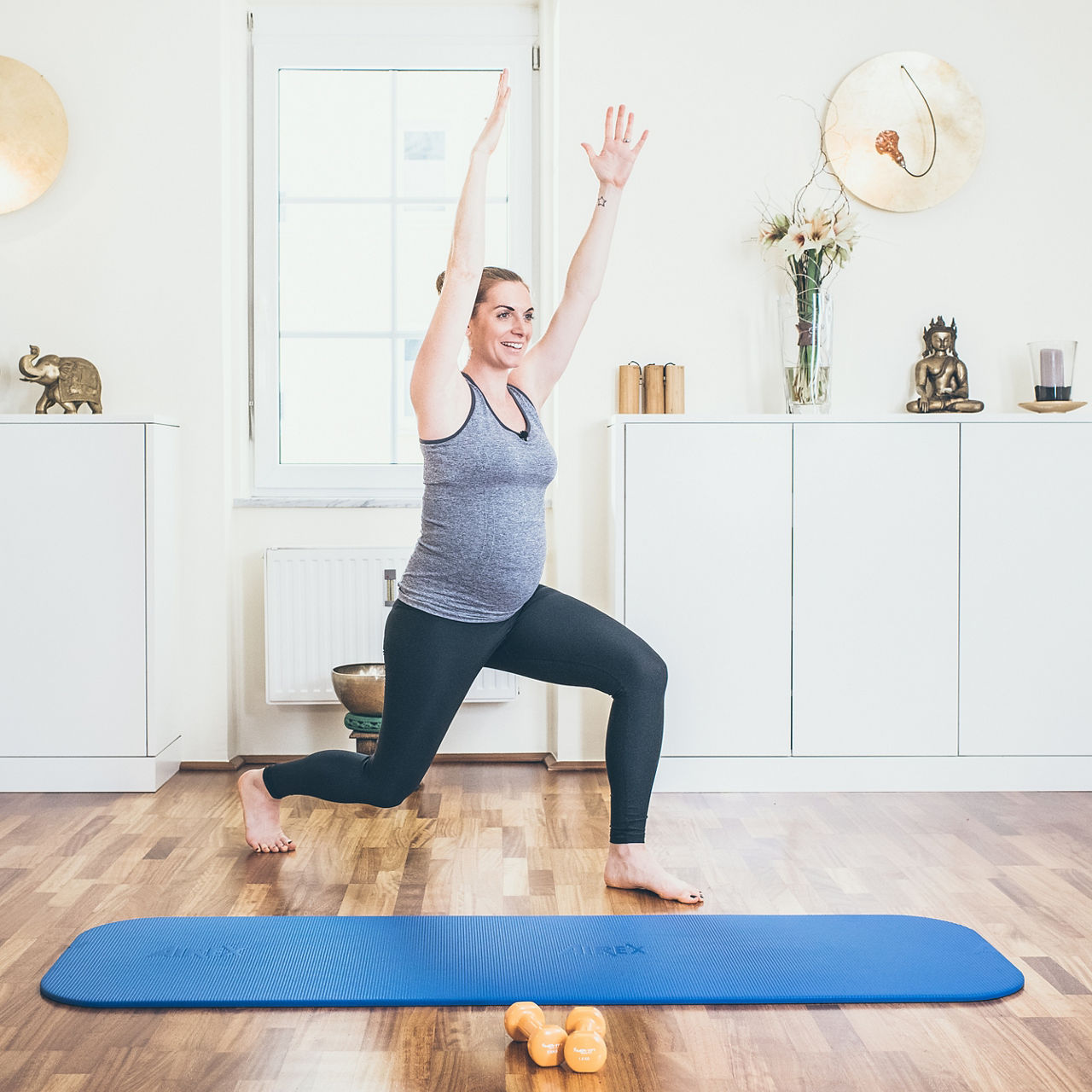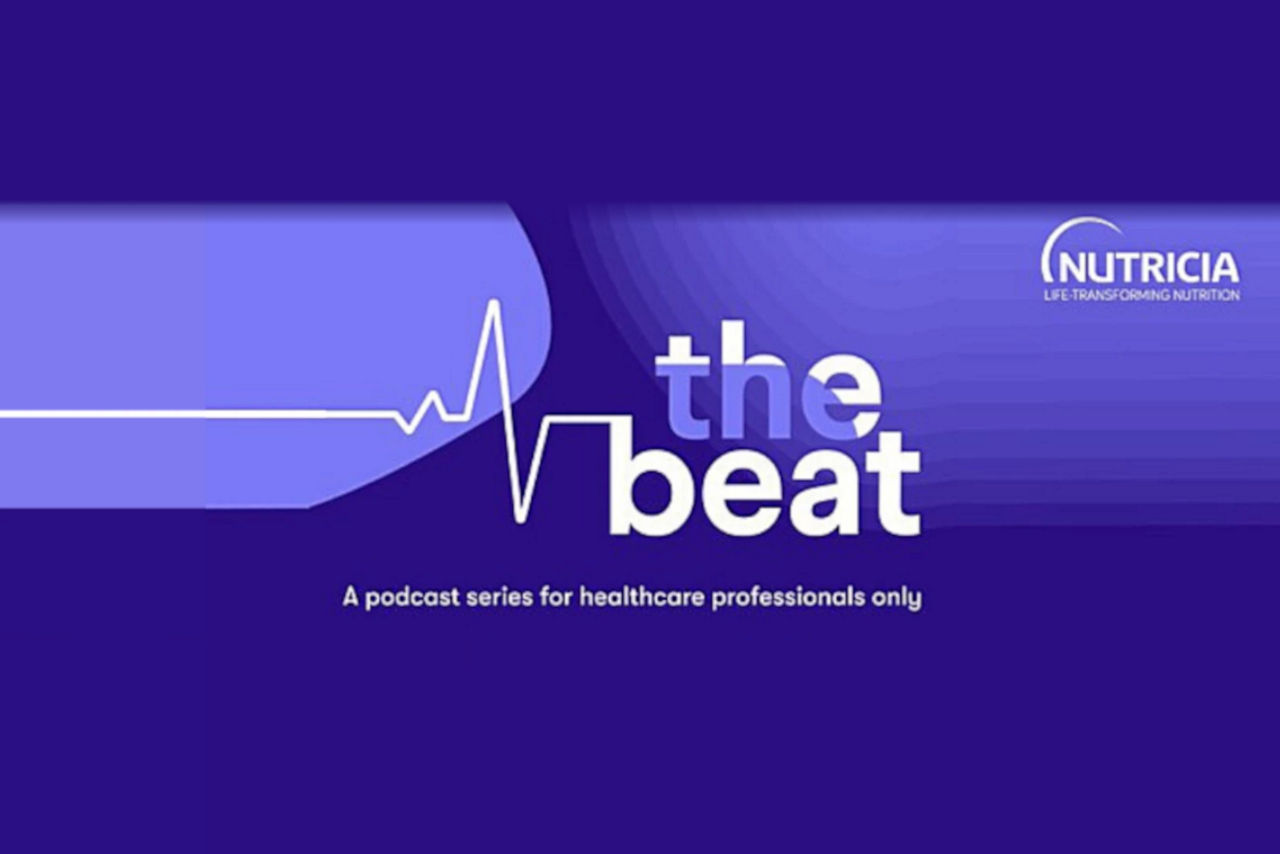Getting mums active during pregnancy: a guide for Healthcare Professionals
All expectant mothers should be encouraged to exercise as part of a healthy lifestyle during their pregnancy, due to the benefits to both mother and baby. Some studies now show that pregnancy exercise has many benefits – in fact, physical activity during pregnancy may well have the power to improve the baby’s heart rate health¹ and brain maturity², boost the mother’s energy levels³ and lower the stress which can impact on the baby’s immune system development⁴. To help healthcare professionals support mothers in getting active during their pregnancy, we have brought together guidance on exercising during their pregnancy; from when to exercise, how to exercise and what exercises should be avoided.
 Aptaclub AT sport schwangerschaft katharina motz sujet1 5
Aptaclub AT sport schwangerschaft katharina motz sujet1 5
Please log in to access this content
Simply log in or register to Nutricia Academy today to access this content as well as a host of other trusted education resources.


Why exercise during pregnancy?
Pregnancy exercise can reduce tiredness, back pain and weight gain, as well as the risk of unplanned caesarean and gestational diabetes. For babies, exercise during pregnancy can improve a baby’s heart rate health, birth weight and brain maturity, so it’s important to encourage mothers to stay active1-3.
For both mother and baby, there are a multitude of benefits to exercising during pregnancy:
Potential benefits for mother
- Reduced lower back pain5, pregnancy constipation12 and tiredness13
- 30% less likely to develop gestational diabetes6
- Less likely to need an unplanned caesarean7,8
- Experience fewer incidences5 and reduced severity10 of depression
- Gain less weight during pregnancy8
- Are less likely to develop urinary incontinence11
- Have reduced incidents of pregnancy constipation12
- Less pregnancy tiredness13
- May have shorter labour5
Potential benefits for baby
- Develop a healthier heart with a lower resting heart rate after birth15
- Be born at what is considered a ‘normal’ birth weight, rather than overweight16
- Be born with more mature brains and are quicker to develop neurologically17
- Experience a reduced risk of respiratory distress at birth (if born to high-risk mothers)18
- Less maternal stress could reduce impact on immune system development19
Exercising safely during pregnancy
There are a number of activities designed specifically for expectant mums, like pregnancy yoga. But if the mother loves to run, swim or go to the gym, they should be able, and encouraged, to continue their usual routine with a few modifications. Some days the mother may feel more energetic than others, so they should always be told to take things at their own pace.
Healthcare professionals should encourage expectant mothers to do the following exercises:
- Running or brisk walking is free and can be done anywhere, anytime. Even a gentle jog or a walk with the dog can raise the heart rate enough to be beneficial for expectant mothers.
- Swimming while pregnant is relaxing for the mind and low impact on the body. Most swimming strokes are safe20, including backstroke – although those with symphysis pubis dysfunction (SPD) may want to avoid the breaststroke22. Some local councils offer free or discounted sessions for expectant mothers.
- Strength training, using moderate rather than heavy weights, is normally safe to continue with if weights are part of a usual exercise routine – but it may be necessary to make a few modifications.
- Yoga and pregnancy yoga can be good methods of aiding relaxation, which also have the benefit of retaining strength and flexibility.
Pelvic floor exercises in pregnancy
The pelvic floor plays a particularly important role during pregnancy and labour22,23. Initially, it supports the weight of the growing baby. Later on, when labour begins, the pelvic floor helps to rotate the baby’s head into the ideal position, ready for birth. As the womb contracts to push the baby down, the gentle resistance from the flexible pelvic floor below encourages the baby’s chin to tuck and their head to turn. Once in this position, it is easier for the baby’s head to pass under the pubic bone, ready for crowning24.
A new mother’s pelvic floor may be understandably weaker after birth. Around 40 percent of women who have given birth experience ‘stress incontinence’ – leaking urine when they sneeze or cough25. Mothers can experience stress incontinence regardless of delivery method, and it is thought to be mostly a consequence of being pregnant in general26. However, pregnant women undertaking pelvic floor muscle training have been found to have a lower incidence of urinary incontinence27 after birth.
How to help pregnant mothers strengthen their pelvic floor
With regular, simple exercises, the pelvic floor muscles can be strengthened in order to reduce the likelihood of certain problems later on28. The most effective way to improve the strength and stamina of pelvic floor muscles is to encourage expectant mothers to combine both short and long squeezes.
Here are a few simple exercises to help strengthen a pregnant woman’s pelvic floor:
- First, lift up and squeeze the back passage as if trying to hold in a bowel movement. Then lift up and hold the muscles of the vagina and bladder, as if holding in urine.
- For short squeezes, hold for a second or two, then release. Rest for one or two seconds before squeezing back and front again.
- For long squeezes, hold for at least four seconds, then release. Rest for a few seconds, then repeat. Over time, try to work up to holding the squeeze for 10 seconds.
- Do as many pelvic squeezes as possible, long and short, before the muscles get tired. Aim to repeat the exercises three times a day.
What should expectant mothers avoid whilst exercising during pregnancy?
Perhaps the simplest change expectant mothers have to make is avoiding lying flat on their backs for long periods of time, especially after 16 weeks. The weight of the bump pressing on certain blood vessels can reduce cardiac output29, cause dizziness and affect the flow of blood that carries nutrients and oxygen to the baby. Instead, expectant mothers should be advised to lie on their sides.
While this means traditional stomach crunches should be avoided during exercise, core and pelvic floor strengthening exercises should still be included in their exercise routines. One way to work the core is for the mother to get onto all fours and make a box shape, with hands under the shoulders, knees under the hips, and a straight back. The stomach muscles should be pulled in, and the back arched towards the ceiling like a cat. This should be held for a few seconds, return to neutral, then repeat30.
What is a ‘safe’ body temperature?
Specific recommendations regarding body temperature during pregnancy are sparse; however, experts agree that expectant mothers should avoid undertaking activities that will raise their core temperature by more than 2°C – or above 38.9°C32. This is because such a temperature change may result in hyperthermia (the opposite of hypothermia). Hyperthermia during pregnancy has been linked to a twofold increase in the risk of birth defects impacting the spine or brain. As such it is not advisable to use hot tubs or spas during pregnancy, and hot yoga should be avoided33.
However, moderate exercise – whether it’s running, swimming or regular yoga – should not raise the core temperature above these levels and should therefore be actively encouraged by healthcare professionals.
Which exercises should be avoided when pregnant?
Although not all of the following activities have been directly linked to harming the baby during pregnancy, certain activities may put expectant mothers in a position where falls or knocks to the unborn baby are more likely. Healthcare professionals should inform pregnant mothers that the following exercises should be avoided34:
- Contact sports like martial arts, football, rugby, squash and hockey all carry a risk of impact.
- Horse riding, cycling, skiing and gymnastics can become more difficult as the baby grows and the centre of balance shifts. Expectant mothers should be advised to avoid these activities, and any others that carry a risk of falling.
- Scuba diving while pregnant should be avoided as the baby has no protection against decompression sickness (‘the bends’) or gas embolism – bubbles in the bloodstream that can cut off blood supply or cause breathing difficulties35. In fact, scuba diving while pregnant has been directly linked to birth malformations36.
- Bikram yoga (or hot yoga) involves a sequence of postures practised in a heated room. While no one has studied the effects of hot yoga specifically, experts agree that pregnant women should avoid raising their core body temperature to reduce the risk of neural tube defects.
IMPORTANT NOTICE: Breastfeeding is best for babies. Infant formula is suitable from birth when babies are not breastfed. Follow-on milk is only for babies over 6 months, as part of a mixed diet and should not be used as a breastmilk substitute before 6 months. We advise that all formula milks including the decision to start weaning should be made on the advice of a doctor, midwife, health visitor, public health nurse, dietitian, pharmacist or other professional responsible for maternal and child care. Foods for special medical purposes should only be used under medical supervision. May be suitable for use as the sole source of nutrition for infants from birth, and/or as part of a balanced diet from 6–12 months. Refer to label for details.
- May LE et al. Aerobic exercise during pregnancy influences fetal cardiac autonomic control of heart rate and heart rate variability. Early Hum Dev 2010;86(4):213-7.
- Labonte-Lemoyne E et al. Exercise during pregnancy enhances cerebral maturation in the newborn: A randomized controlled trial. J Clin Exp Neuropsychol 2016:1-8.
- Gaston A, Prapavessis H. Tired, moody and pregnant? Exercise may be the answer. Psychol Health 2013;28(12):1353-69.
- Marques AH, Bjorke-Monsen AL, Teixeira AL, Silverman MN. Maternal stress, nutrition and physical activity: impact on immune function, CNS development and psychopathology. Brain Research. 2015;1617:28–46.
- Pennick V, Liddle SD. Interventions for preventing and treating pelvic and back pain in pregnancy. Cochrane Database Syst Rev 2013(CD0011):1-100.
- Sanabria‐Martínez G et al. Effectiveness of physical activity interventions on preventing gestational diabetes mellitus and excessive maternal weight gain: a meta‐analysis. BJOG 2015;122(9):1167-74.
- Price BB et al. Exercise in pregnancy: effect on fitness and obstetric outcomes-a randomized trial. Med Sci Sports Exerc 2012;44(12):2263-9.
- Domenjoz I et al. Effect of physical activity during pregnancy on mode of delivery. Am J Obstet Gynecol 2014;211(4):401.e1-e11.
- Gaston A, Prapavessis H. Tired, moody and pregnant? Exercise may be the answer. Psychol Health 2013;28(12):1353-69.
- Robledo-Colonia AF et al. Aerobic exercise training during pregnancy reduces depressive symptoms in nulliparous women: a randomised trial. J Physiother 2012;58(1):9-15.
- Perales M et al. Benefits of aerobic or resistance training during pregnancy on maternal health and perinatal outcomes: A systematic review. Early Hum Dev 2016;94:43-8.
- Shi W et al. Epidemiology and risk factors of functional constipation in pregnant women. PloS one 2015;10(7):e0133521.
- Gaston A, Prapavessis H. Tired, moody and pregnant? Exercise may be the answer. Psychol Health 2013;28(12):1353-69.
- Barakata et al. Exercise during pregnancy is associated with a shorter duration of labor. A randomized clinical trial 2018, 224 33-40.
- May LE et al. Aerobic exercise during pregnancy influences fetal cardiac autonomic control of heart rate and heart rate variability. Early Hum Dev 2010;86(4):213-7.
- Bisson M et al. Physical activity volumes during pregnancy: A systematic review and meta-analysis of observational studies assessing the association with infant’s birth weight. AJP Reports 2016;6(02):e170-e97.
- Labonte-Lemoyne E et al. Exercise during pregnancy enhances cerebral maturation in the newborn: A randomized controlled trial. J Clin Exp Neuropsychol 2016:1-8.
- Muktabhant B et al. Diet or exercise, or both, for preventing excessive weight gain in pregnancy. Cochrane Database Syst Rev 2015 Jun 15;(6):CD007145.
- Marques AH, Bjorke-Monsen AL, Teixeira AL, Silverman MN. Maternal stress, nutrition and physical activity: impact on immune function, CNS development and psychopathology. Brain Research. 2015;1617:28–46.
- Juhl et al. Is swimming during pregnancy a safe exercise? Epidemiology 2010;21(2):253-8.
- Tommy’s. Symphysis Pubis Dysfunction (SPD) or Pelvic Girdle Pain (PGP) [Online]. Available at: https://www.tommys.org/pregnancy-information/pregnancy-complications/symphysis-pubis-dysfunction-spd-or-pelvic-girdle-pain [Accessed: December 2016].
- NHS Choices. What are pelvic floor exercises (Kegel exercises)? [Online]. Available at:http://www.nhs.uk/chq/pages/1063.aspx?categoryid=52 [Accessed: December 2016].
- Ashton-Miller J, Delancey J. Functional anatomy of the female pelvic floor. Ann NY Acad Sci 2007;1101(1):266-96.
- Herbert J. Pregnancy and childbirth: the effects on pelvic floor muscles. Nursing Times 2009;105(7):38-41.
- Sangsawang B, Sangsawang N. Stress urinary incontinence in pregnant women: a review of prevalence, pathophysiology, and treatment. Int Urogynecol J 2013;24(6):901-12.
- McKinnie V et al. The effect of pregnancy and mode of delivery on the prevalence of urinary and fecal incontinence. Am J Obstet Gynecol 2005;193(2):512-7.
- Boyle R et al. Pelvic floor muscle training for prevention and treatment of urinary and faecal incontinence in antenatal and postnatal women. Cochrane Database Syst Rev 2012;10:CD.
- Boyle R et al. Pelvic floor muscle training for prevention and treatment of urinary and faecal incontinence in antenatal and postnatal women. Cochrane Database Syst Rev 2012;10:CD007471.
- Bamber J, Dresner M. Aortocaval compression in pregnancy: the effect of changing the degree and direction of lateral tilt on maternal cardiac output. Anesth Analg 2003;97(1):256-8.
- Livestrong. Max heart rate while pregnant [Online]. Available at: http://www.livestrong.com/article/322176-max-heart-rate-while-pregnant/ [Accessed: December 2016].
- Gowda RM et al. Cardiac arrhythmias in pregnancy: clinical and therapeutic considerations. Int J Cardiology 2003;88(2):129-33.
- Chambers CD. Risks of hyperthermia associated with hot tub or spa use by pregnant women. Birth Defects Res A Clin Mol Terato 2006;76(8):569-73.
- Chan J et al. Hot yoga and pregnancy: Fitness and hyperthermia. Can Fam Physician 2014;60(1):41-2.
- Tommy’s. Exercises to avoid in pregnancy. Available at: https://www.tommys.org/pregnancy-information/im-pregnant/exercise-pregnancy/exercises-avoid-pregnancy [Accessed May 2019].
- Camporesi EM. Diving and pregnancy. Semin Perinatol 1996;20(4):292-302.
- Damnon F et al. Should a pregnancy test be required before scuba diving? Br J Sports Med 2016 Sep;50(18):1159-60.

